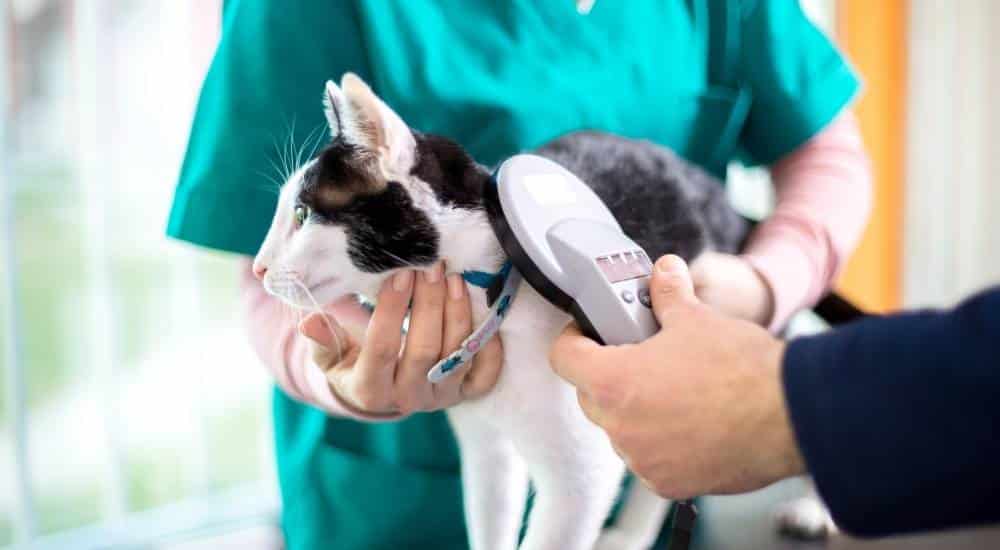It’s finally that time of the year again, summer is almost here and we should all be celebrating! But did you know that summer is kicked off with National Chip Your Pet Month? May is officially recognized as this holiday by the American Kennel Club (AKC) and was made to educate responsible pet parents on the importance of microchipping your furry little friend.
So what is a microchip for pets?
Maybe 20 years ago, people thought these little microchips for your pets were expensive and useless without the technology. Today, these old assumptions couldn’t be further from the truth. Microchipping your pet is the most effective way in reuniting lost pets with their owners!
Cats and dogs are curious little creatures that sometimes wander out of sight. If a pet meanders far from home, their microchip will be crucial in reuniting with them and could save their life.
What is a Pet Microchip?
A pet microchip is a tiny device, about the size of a grain of rice, that is rooted in the scruff of an animal’s neck. The purpose of a microchip is to give your pet a unique identifier in the event they get lost.
How Does it Work?
It seems unbelievable that someone could scan an animal for information, but the technology is actually quite simple. Pet microchips are radio-frequency identification (RFID) transponders and when scanned transmit a unique ID number. This means there are no batteries or power required when scanning a microchip for a pet’s unique ID number.
Pull quote: “Microchips are not tracking devices and cannot report your pet’s location.”
A common misconception about a microchip in a dog or cat is that it works like a GPS. Microchips are not tracking devices and cannot report your pet’s location; however, that doesn’t mean microchips aren’t effective. Solely relying on a small GPS is risky because the device depends on batteries that can be lost, die, or simply fall off with a pet’s collar. A GPS will only tell you your dog’s approximate location, but it can’t provide others your contact information to help reunite you with your pet.
Microchips, on the other hand, are inserted into the skin and are permanent. If your animal is lost and the chip is scanned, it will provide your information to the person trying to return your pet.
What’s the Cost of a Dog or Cat Microchip?
Inserting a special device into your animal sounds like it could be an expensive endeavor, but the chip is actually very affordable. According to Pet Finder, the average cost of a pet microchip is $45, but some transponders are as much as $100.
If the cost still seems pricey, remember that the chips don’t need routine care, maintenance, or replacement. Microchips are designed to last for 25 years.
The Microchip Procedure
Although a microchip is an important and potentially life-saving device, they’re easy to buy and administer. Microchips have become so ubiquitous in the veterinary world that most vets can perform the procedure. This means you don’t have to stress about locating a specialist.
Most importantly: a microchip does not require surgery. Microchips are injected under an animal’s loose skin; for example, a dog microchip is commonly inserted in the skin between the shoulder blades. The procedure only lasts a few minutes and is no more invasive than your pet’s routine vaccinations.
Microchips are also very secure. An animal’s subcutaneous (the fat and connective) tissue will bond to the chip in about 24 hours. This prevents the chip from moving around in your pet’s body. It’s possible the microchip can move before bonding to the tissue, but it cannot get lost within your pet’s body.
There is a minor chance your pet could potentially be irritated by the procedure and experience minor, temporary bleeding. Most pet owners report no side effects to the microchip procedure.
Benefits of a Dog or Cat Microchip
Microchips have helped bring pets back to their owners for years. When an animal has a microchip it increases the chance of the owner being identified, and as chips become more common those numbers will continue to rise.
As pet parents, we never want to imagine losing our beloved animals, but it can happen. Curious housecats can sneak out open windows and rambunctious pups can dig their way under fences. So when these animals turn up at shelters, they should be easily identifiable.
In fact, checking for a microchip in lost dogs and cats is one of the first things done by a shelter worker. In 2009, the American Veterinary Medical Association (AVMA) conducted a study on microchipped pets that entered animal shelters. This study showed that 74% of dogs and 63.5% of cats with microchips that were turned into shelters were reunited with their owners.
Luckily, the information associated with a microchip can change depending on your needs. Microchips will not be defunct if you:
- Move or change your information
If you move to a different address or change your name you can simply contact the company that registered your microchip. Some companies charge a small fee, but they will happily make your information up to date.
- Adopt a pet with an existing microchip
If you adopt an animal who already has a chip, the microchip company can update your info. If you’re unsure what brand of chip your pet has, your vet or local animal shelter can read it for you.
Microchip Registration for a Dog or Cat
Pet owners turn to microchips as being a unique identifier in case their furry friend gets lost. However, microchipping a dog or cat is useless unless the chip number is properly registered with a national pet recovery database.
Registration takes less than five minutes and requires your contact information, as well as basic info such as your pet’s breed, sex, coat color, and distinct markings. Many pet owners also opt for a special tag or collar that indicates the presence of a microchip in their pet, so that anyone who finds the animal knows right away.
Where to Buy a Microchip
During the early days of microchipping, different companies required unique scanners to read their chips. Nowadays there are universal scanners that can read any microchip, so you never have to worry about the brand you chose is incompatible.
Below are some trusted pet microchipping companies:
It’s always good to identify your pet’s microchip number on their collar or tags to make it even easier for others to spot it. You can order a custom collar or tag through PetLink.
Microchip Dog Lookup Services
Register your pet’s ID number with a trusted recovery service that can access other microchip databases. It’s best if the service is a member of the American Animal Hospital Association (AAHA) and can access the AAHA Universal Microchip Lookup Tool. The larger the database, the easier it will be to get reunited with your little fuzzball.
If you stumble upon a lost pet, contact your local animal shelter. If you find a pet with an identifiable microchip number on a tag or collar, you can search it on the AAHA database.





